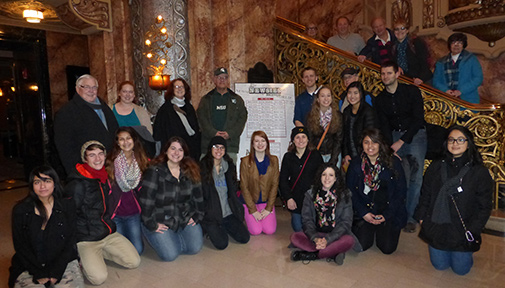News From
Regional Sections
Section Meetings in Cincinnati
Everyone attending the 2015 Annual Conference in Cincinnati has a great opportunity to learn more about USIT’s Regional Sections. Thursday morning, March 19 all sections hold meetings where information is shared about regional activities. All are welcome at these events which can include awards, elections, and lively conversations. A list of sessions and their meeting places is included in the Conference program and is available on the mobile app.
Midwest Regional Section: Design Competition
The Midwest Mechanical Design Competition registration is now open! This is a chance for you to show off your skills, network with students from across the Midwest, and have your work critiqued by theatre, engineering, physics, and other professionals. The competition is open to college students of all ages and skills, including undergraduate and graduate students. In the competition, students build a small, working prototype for a specified machine — trebuchet, cannon, dart shooter, etc. — and then test them out at the regional competition in May. This year, competitors will be building the wildest contraptions that they can come up with to achieve an otherwise mundane task, otherwise known as a Rube Goldberg Machine. All competitors get T-shirts. The winner will receive a Conference registration to the 2016 USITT Conference and Stage Expo in Salt Lake City. Come join us for a day of flipping, falling, bouncing, noise-making fun. For more information about the competition, including how to register, please see the website.
I hope to see you there in May!
Midwest Regional Section: Newsies on-stage and backstage

December 13 was an enjoyable and enlightening day for 26 members of the Midwest Regional Section who attended a backstage tour and matinee performance of the touring production of Newsies. The show was being performed in Chicago at the historic Oriental Theatre, more commonly known today as the Ford Center for the Performing Arts. Jennifer, head of show props and Noah, head carpenter, told the group about the technical challenges of the show as well as fielded questions. Before the opening of the tour in Philadelphia, the show had five weeks in Schenectady to work out all of the technical issues.This set was newly built for traveling and did not incorporate any of the pieces used in the NY production which played at the Nederlander, even though the set was essentially the same as the Broadway production.
This show travels in nine trucks and had a 16 hour load-in. The main set is comprised of three, 24 foot high aluminum “towers” which serve as the main acting area for much of the show. The towers are tracked up and downtstage on cables within the show deck and contain a “turtle” inside the unit which allows the unit to rotate different degrees on the deck. There are LED “birdies” hidden within each of the towers. Each of the towers takes 2 1/2 hours to assemble during load in. Noah told us that he has 35 set carts used solely by his carpentry crew.
The show travels with a road crew of 15 and an additional 65-75 locals are hired for load in. There are 10-12 local crew hired as dressers. Jennifer said the main prop used in many different ways on the show are the newspapers, all printed for 1889, and as many as 200 have to get thrown out per performance. She talked about how the flash effect used for the cameras had to be done differently due to fire laws in Chicago. A light bar incorporates a CO2 cartridge and powder to create a flash effect without pyro as they have used in other cities.
One of the participants of the day commented: "While the very informational backstage tour was very interesting, the transfer to the in house patron was pure entertainment, plus to have the technical workings in mind, only added to a great day of pure live theatre. It was VERY worth the trip, and the time spent.” Another said "The event was great! I personally enjoyed the performance all the more, because thanks to the backstage tour before the show, I already knew how everything worked and where all of the light fixtures were hidden, etc., so didn't have to spend the time and brain power figuring that out during the show the way I usually do.”

